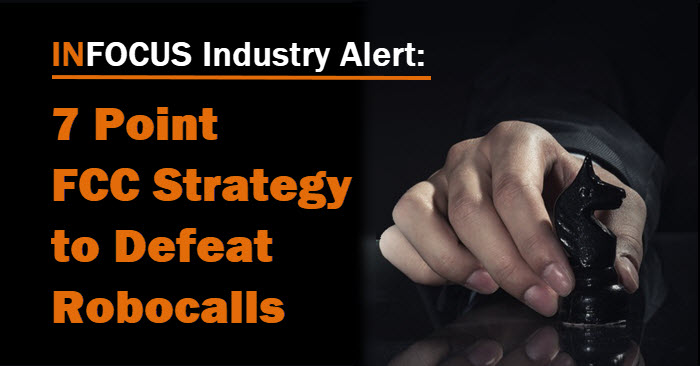The FCC adopted the Consumer Advisory Committee’s (CAC) recommendation for unwanted call blocking during their September 18th meeting. The intent of the seven action items is to focus on the importance of allowing voice-service providers the flexibility to address illegal robocalls in a way that does not inadvertently block legitimate business-to-consumer calls.
Background
For some perspective, we go back to March 23rd when the FCC issued their initial robocall recommendations proposal (see FCC Declares War on Robocallers). Their goal was to facilitate a process that allowed voice-service providers to block illegal robocalls. This proposal was made available for comment in a Notice of Proposed Rulemaking and Notice of Inquiry. Based on input from those in the teleservices industry, they sought to develop criteria for differentiating illegal robocalls from those which are legitimate.
“We know the problem of illegal robocalls is complicated and the solutions are many – and today’s proposals are only the Commission’s first step toward defeating this scourge.” — FCC Chairman Ajit Pai
The FCC believed that the best strategy for achieving their goal of eliminating illegal robocalls was to work with the industry by removing regulatory roadblocks. They wanted to address competing policy considerations regarding call blocking. Their goal was to arrive at an effective solution that ensures consumer protection without hindering legal business-to-consumer communications.
On May 19th the FCC adopted the CAC’s proposal of recommend steps that the agency should take to combat unwanted robocalls. Their 11 Recommendations for Unwanted Calls covered the topics of education, enforcement, and the consumer complaint process.
That brings us to September 18th. The CAC pushed this issue to the next level by adopting their proposed recommendation to the FCC, Recommendation Regarding Unwanted Call Blocking. It included the following action items.
7 Point Unwanted Call Blocking Recommendation
- Suspected Illegal Robocalls. Permit and encourage voice-service providers to block robocalls in certain specified circumstances to protect subscribers from suspected illegal robocalls.
- Subscriber Requested Blocking. Permit and encourage voice-service providers to block calls when the subscriber to the originating number has requested that the calls be blocked.
- Suspicious Call Origination Blocking. Permit and encourage voice-service providers to block calls (and to develop any industry practices and procedures needed to facilitate such blocking) in the following circumstances.
- Calls originating from invalid numbers
- Calls originating from numbers not allocated to any provider
- Calls originating from numbers that are allocated to a provider but not assigned to a subscriber
- Blocking Service Awareness. Encourage voice-service providers that have implemented call blocking services to inform current and potential subscribers through, at minimum, their published terms of service.
- Collaborative Blocking Solutions. Encourage stakeholders from consumer and industry sectors to work collaboratively to develop processes and solutions whereby unintended blocking of legitimate callers can be remedied in a timely and efficient manner.
- Optional Blocking Tools. Encourage voice providers to offer consumers optional tools to block robocalls beyond the four categories mentioned in the NPRM and NOI and make information about those options easily available to current and potential subscribers. Voice-service providers (and third-party providers) should be afforded sufficient flexibility to establish standards that can be utilized to meet this goal.
- Blocking Impact Review. Study the implementation and effectiveness of blocking measures, within two years after the new rule is finalized in order to assess the impact of various blocking measures.
The meeting concluded with Matthew Berry, Chief of Staff for FCC Chairman Ajit Pai, stating that illegal robocalls are a “top priority” for the FCC, but he emphasized that attacking it would require a multi-pronged strategy. The overall consensus was that solving the problem will not happen overnight.
CONCLUSION
We are optimistic that the intent of these recommendations is to find a balance between blocking illegal robocallers and preserving the legitimate right of businesses to communicate with consumers. Still, there is cause for concern. Even though technology within the teleservices industry has made incredible advancements over the last 10 years, there is no reliable way for voice-service providers to effectively block illegal robocalls without legitimate calls being caught in the sweep.
Every day, legitimate business-to-consumer calls are appearing on consumer phones as “suspected scam” or simply blocked. For debt collections agencies this is a critical issue that directly affects their business and needs to be considered as new call blocking technologies are being developed.
The good news for the telemarketing industry is that the FCC is aware of the problem and attempting to find a reasonable balance between consumer protection and the need for businesses call consumers for legitimate purposes. The bad news is that implementing any new regulatory solutions will take time. For now we must that expect voice-service providers will continue to provide imperfect blocking tools that catch more than illegal robocallers in their technological nets.
